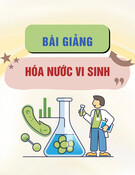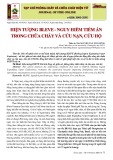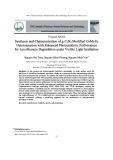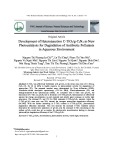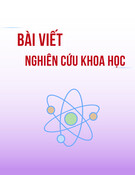
TNU Journal of Science and Technology
229(06): 330 - 339
http://jst.tnu.edu.vn 330 Email: jst@tnu.edu.vn
ANALYSIS OF CHEMICAL FRACTIONS AND EVALUATION OF COPPER (Cu)
CONTAMINATED LEVELS IN SOIL SAMPLES OBTAINED FROM A Pb/Zn
MINING SITE LOCATED IN HICH VILLAGE, THAI NGUYEN PROVINCE
Vuong Truong Xuan*, Phan Thanh Phuong, Pham Thi Thu Ha
TNU - University of Sciences
ARTICLE INFO
ABSTRACT
Received:
08/5/2024
Currently, the contamination of heavy metals within ore mining regions is
pronounced both domestically in Vietnam and globally. The primary objective of
this study is to elucidate the chemical speciation of copper (Cu) and conduct an
assessment of the magnitude and probability of contamination of Cu in soil
samples procured from the Pb/Zn mining, at the Hich village, Dong Hy district,
Thai Nguyen province, in order to furnish critical data pertinent to the
environmental stewardship of soil resources within this geographical domain. The
determination of Cu‟s chemical fractions in soil specimens was conducted
following Tessier's extraction procedure, utilizing the ICP-MS technique. Results
revealed that the mean Cu concentrations across the five tailing samples ranged
from 15.524 to 35.192 mg kg-1, while in the seven agricultural samples,
concentrations ranged between 15.359 to 21.198 mg kg-1. Predominantly, Cu was
identified within the soil fractions in the order of residues (F5) > carbonate (F2) >
Fe/Mn oxides (F3) > exchangeable fraction (F1) > organic carbon (F4).
Compliant with Vietnamese standards, Cu concentrations in agricultural soil
samples remained below permissible limits. Based on the Igeo index, the majority
of soil samples exhibited mildly contaminated levels. Furthermore, according to
the Risk Assessment Code (RAC), 11 out of the 12 analyzed soil samples were
classified as having a medium risk level.
Revised:
31/5/2024
Published:
31/5/2024
KEYWORDS
Heavy metal pollution
Chemical speciation
Soil pollution
Contaminated evaluation
Heavy metal content
PHÂN TÍCH DẠNG HOÁ HỌC VÀ ĐÁNH GIÁ MỨC ĐỘ Ô NHIỄM
CỦA ĐỒNG (Cu) TRONG MẪU ĐẤT Ở KHU VỰC MỎ Pb/Zn LÀNG HÍCH,
TỈNH THÁI NGUYÊN
Vương Trường Xuân*, Phan Thanh Phương, Phạm Thị Thu Hà
Trường Đại học Khoa học - ĐH Thái Nguyên
THÔNG TIN BÀI BÁO
TÓM TẮT
Ngày nhận bài:
08/5/2024
Hiện nay, sự ô nhiễm của kim loại nặng trong các khu vực khai thác quặng đang
trở nên rất nghiêm trọng tại Việt Nam và trên toàn cầu. Mục đích của nghiên cứu
này là phân tích dạng hóa học của đồng (Cu) và đánh giá mức độ, nguy cơ ô
nhiễm của nguyên tố này trong mẫu đất ở khu vực mỏ Pb/Zn Làng Hích, huyện
Đồng Hỷ, tỉnh Thái Nguyên, để góp phần có được những thông tin cần thiết trong
quản lý môi trường đất ở khu vực này. Hàm lượng Cu trong các dạng hóa học
trong các mẫu đất được phân tích theo phương pháp chiết Tessier, sử dụng kỹ
thuật ICP-MS. Kết quả cho thấy nồng độ trung bình của Cu trên năm mẫu cát từ
15,524 đến 35,192 mg kg-1, trong khi đó ở bảy mẫu nông nghiệp, nồng độ dao
động từ 15,359 đến 21,198 mg kg-1. Chủ yếu, Cu được xác định trong các phân tử
đất theo thứ tự: cặn (F5) > cacbonat (F2) > oxit Fe/Mn (F3) > phân tử trao đổi
(F1) > cacbon hữu cơ (F4). Tuân thủ các tiêu chuẩn Việt Nam, nồng độ Cu trong
các mẫu đất nông nghiệp vẫn ở dưới ngưỡng cho phép. Dựa trên chỉ số Igeo, hầu
hết các mẫu đất cho thấy mức độ ô nhiễm nhẹ. Hơn nữa, theo Mã đánh giá rủi ro
(RAC), 11 trong số 12 mẫu đất được phân tích được xác định là có mức độ rủi ro
trung bình.
Ngày hoàn thiện:
31/5/2024
Ngày đăng:
31/5/2024
TỪ KHÓA
Ô nhiễm kim loại nặng
Dạng hóa học
Ô nhiễm đất
Đánh giá ô nhiễm
Hàm lượng kim loại nặng
DOI: https://doi.org/10.34238/tnu-jst.10317
* Corresponding author. Email: xuanvt@tnus.edu.vn





